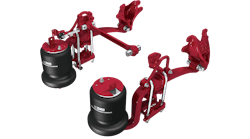REPOSSESSIONS and liquidations of trucking equipment in the fourth quarter of 2009 declined significantly as compared to similar figures from 2008, according to Nassau Asset Management's NasTrac Quarterly Index (NQI). Nassau Asset Management is a leading asset management firm in the equipment leasing industry.
The figures, culled from the company's activity reports for both repossessions and orderly liquidations, also indicated a decline in machine tool repossessions, along with a rise in repossessions for both construction and printing equipment, offering a mixed message on the current state of the American economy.
Trucking repossessions dropped by 55% in the latest NQI (for Q4), marking the second straight quarter of considerable declines. The results in these two quarters follow in the wake of a steady increase in activity in this sector, beginning in early 2008.
Machine tool repossessions processed by Nassau followed the same track as trucking repossessions. They declined by 20% in Q4 2009, following a 55% decline in Q3 2009, as compared to the same periods in 2008. However, other sectors continued to report increased activity in the NQI. Construction repossessions and liquidations rose by 23% during the quarter and printing equipment repossessions increased by more than 200%, as compared to the same total in 2008.
“2009 ended with two quarters of mixed results, after beginning the year with two very difficult quarters,” says Ed Castagna, president of Nassau Asset Management. “These numbers indicate some relief for the battered trucking and machine tool verticals of the equipment leasing sector, but that relief has yet to spread to other important sectors.”
Castagna adds: “Based on the data in the NQI and information gathered in our ongoing communication with clients and other business leaders in the various economic sectors in which we operate, we foresee more months of these varied results before things improve.”
Continuing improvement
The 55% drop in Q4 truck repossessions follows a 44% decline in the previous reporting period. This severe reduction in activity seems to indicate that the trucking sector has positioned itself for a turnaround that unfortunately has yet to begin, according to Castagna.
Data from the Department of Transportation's Bureau of Transportation Statistics supports this trend. The Freight Transportation Services Index (TSI), which measures the month-to-month changes in freight shipments in ton-miles, was unchanged in December from its November 2009 level. Meanwhile, although the index recorded a 4.1% decline for all of 2009, it increased by 2.9% during the last seven months of the year. Even with its recent surge, the Freight TSI is down 14.8% from its historic peak, which occurred in May 2006.
In addition, FTR Associates, a leading freight transportation forecaster, reported that January 2010 Class 8 truck total net orders for all major North American OEM's were at the lowest level since July 2002. January's order activity was down 46.4% from December 2009 and was 20.1% lower than the same month a year ago. This decline in January activity followed a brief spurt of activity in late 2009, when FTR analysts recorded fleets taking advantage of open build slots.








